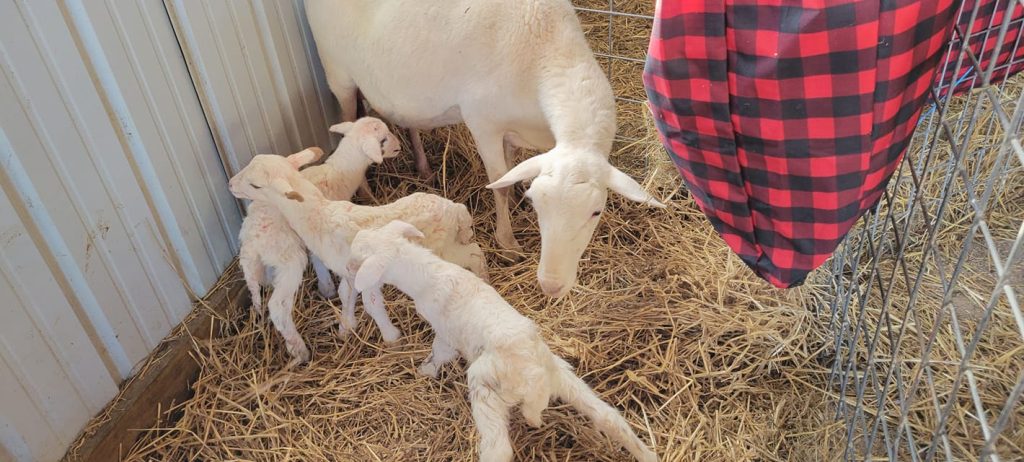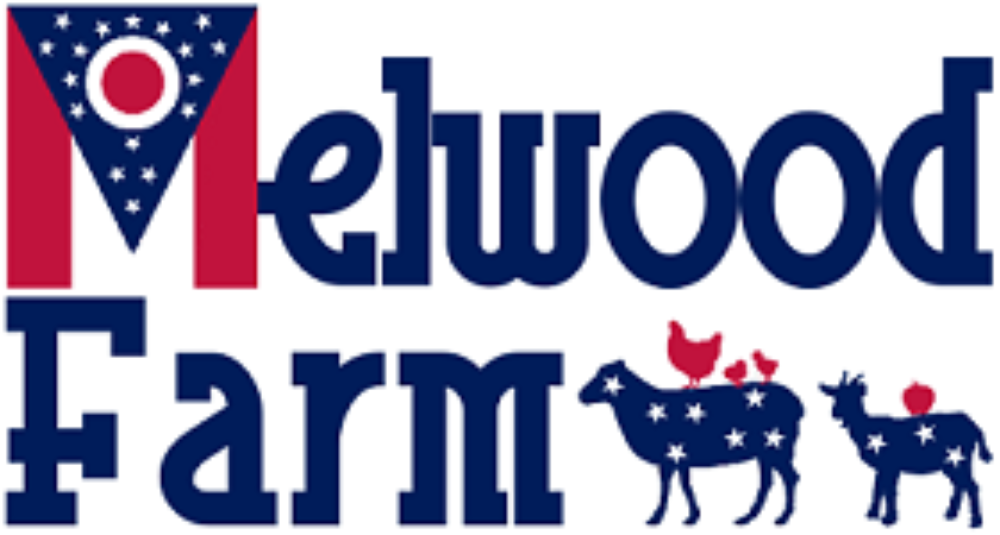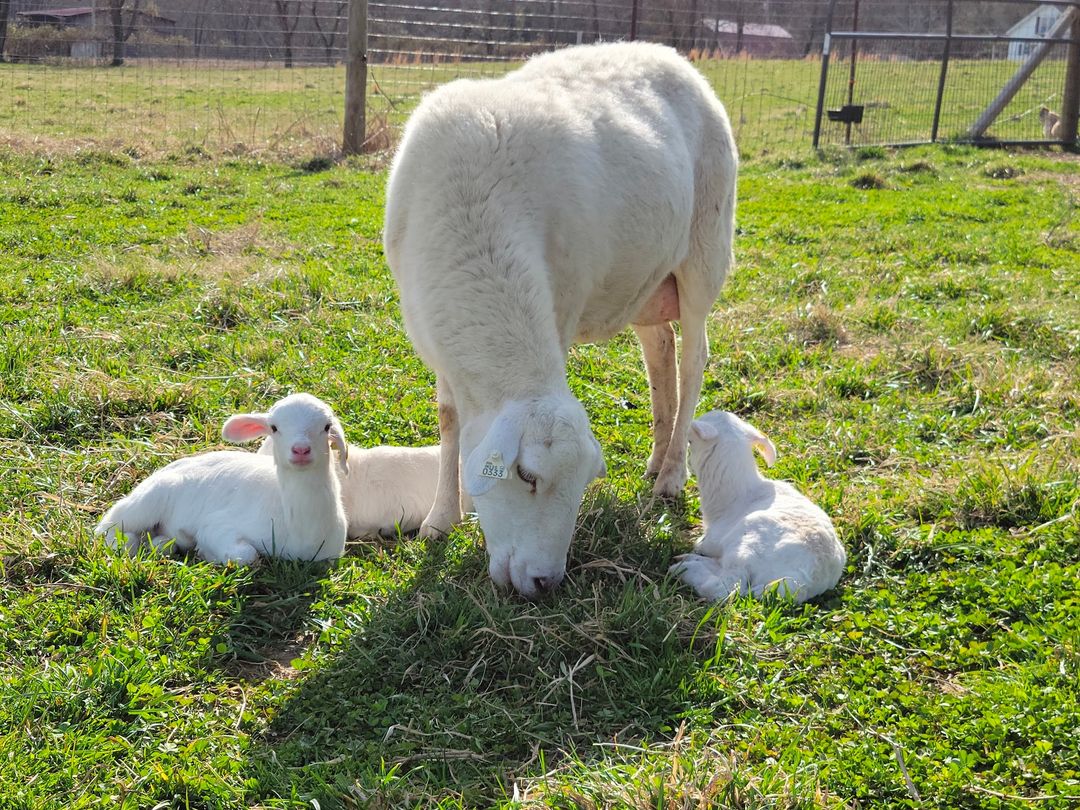Shepherds often toss around three terms when discussing ewes: fertility, prolificacy, and fecundity. If you’re like me, you hear these terms, develop an understanding of them, and then forget them! Writing this post is my attempt to burn them into my memory and to get others thinking about them, too.
We can measure a ewe’s reproductive ability “… by fertility, fecundity, and prolificacy. Fertility is defined as [the] number of lambing per year, fecundity is the number of lambs produced per year, and prolificacy is defined as a litter size.” (source) Let’s look closer at each of those terms.
Fertility
We now know that fertility refers to how many times a ewe produces lambs in a single year. Many farms schedule their ewes to lamb once yearly; usually in spring. This is a common practice that requires the fewest inputs. The lambs are born when pastures are green and growing quickly. That means the ewes require less feed/hay. Temperatures are mild so they can be born on pasture with no additional housing required. Finally, the ewes breed in the fall, which is naturally their peak breeding season. This means that one should expect 100% pregnancy rates without the use of hormone therapies such as CIDRs or injections. All these things make the process simpler, less expensive, and easier for both the sheep and the shepherd.
However, some choose to lamb at other times of year and/or more frequently. This practice requires a higher fertility rate from the ewes because we are asking her to produce lambs out of season or more often than what is “normal”. Feed costs are higher in this model because the ewes need additional nutrition during the winter months when forage is minimally available. Added shelter may be necessary since lambs will be born during freezing or hot/humid temperatures. Some breeds require the use of hormone therapies to breed out of season. Essentially, this management style requires additional work and money.
The ewe’s age, health, body condition, lambing interval, and genetics also affect fertility. Overly thin and obese ewes are less likely to conceive than fit ewes with just a little fat covering. Aged ewes are less likely to conceive than young ones. Ewes that have already raised lambs in a year may be less likely to re-breed in that same year. Genetics also play an enormous role in fertility rates.
Prolificacy
Prolificacy refers to the number of lambs produced in a single litter. Ewes that consistently produce twins, triplets, or even quadruplets are more prolific than those that have single lambs. Litter size is highly dependent on ovulation rate of the ewe at the time of mating. Many factors affect ovulation rate including genetics, age, nutrition, and hormones. Some sheep breeds are more likely to produce multiple lambs per litter than others. Most maiden ewes produce singles their first time lambing.
Shepherds sometimes use “flushing” to increase the ovulation rate among ewes. Flushing refers to providing extra feed to the ewes in the weeks before breeding. Read about what happened on my farm when I accidentally flushed my ewes!
Fecundity
Fecundity is the number of lambs produced per year, or lambing percentage. We often see or hear other shepherds boasting or lamenting about their lambing percentages. Both fertility and prolificacy, along with the shepherd’s chosen production model influence fecundity scores. Any ewe that cannot or does not lamb more than once a year will have lower fecundity (lambing percentage) than a ewe that lambs twice in that year.
Example: Ewe A lives on a farm that schedules lambing in May. Ewe A gives birth to a nice set of twins. Her fecundity score is 200%. Ewe B lives on a farm that practices accelerated lambing. She has a set of twins in March, and another set of twins in November. Ewe B’s fecundity score is 400%, double the score of Ewe A. Ewe C also lives on a farm that schedules a single lambing in May. She gives birth to triplets. Her fecundity score is 300%.
How do St. Croix Hair Sheep Perform?
Luckily, it is common for St. Croix Hair Sheep to breed at any time of year and to conceive and lamb more than once a year (fertility). It is unnecessary to flush St. Croix ewes because they almost always produce twins (prolificacy). Triplets are not uncommon, with some ewes even producing quadruplets! Breeders should expect their St. Croix ewes to have no less than a 200% fecundity score by their second lambing.
I own several ewes that have proven they have high fertility, prolificacy, and fecundity. In fact, I ask every ewe on the farm to produce an extra lamb crop in a single year at least once in her lifetime. This helps me evaluate their performance in those areas more accurately. So far, I have multiple ewes that have fecundity scores of 400% in a given year, and two that have reached scores of 600% because they had two sets of triplets! The ewe pictured at the top of this post had a score of 500% this year. I posted about her on Facebook because I was so impressed with her.
Demanding higher performance via accelerated lambing requires more significant labor and financial inputs, even for St. Croix. However, the ewes do not need hormonal therapy, flushing, or large amounts of supplemental feeds to do it. I provide a little feed (0.5-1 pound per day), loose minerals, all the hay they want in the winter months, clean water, and access to shelter when needed. The ewes do the rest of the work.


